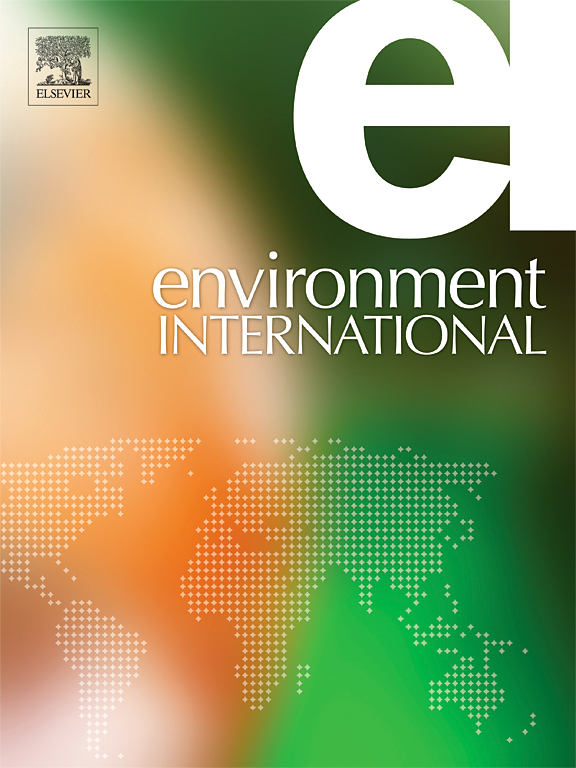15 种全氟化烷基和多氟化烷基物质 (PFAS) 混合物单次口服后的动力学 - 在一名男性志愿者身上进行的试点调查
IF 9.7
1区 环境科学与生态学
Q1 ENVIRONMENTAL SCIENCES
引用次数: 0
摘要
全氟烷基和多氟烷基物质(PFAS)是无处不在的环境污染物,长链化合物在人体内的半衰期长达数年,会在血浆中积累并达到可测量的水平。相比之下,短链和 "替代 "全氟辛烷磺酸在人体中的含量较低,或在本底暴露中检测不到。这可能是由于暴露量较低,也可能是由于半衰期比长链化合物短得多。为了获得更好的动力学数据,在一项试点调查中,一名健康志愿者口服了 15 种主要由 13C 标记的 PFAS("MPFAS")混合物(MPFBA、MPFPeA、MPFHxA、MPFHpA、MPFOA、MPFNA、MPFDA、MPFUdA、MPFDoA、PFBS、MPFHxS、MPFOS、DONA、HFPO-DA、6:2FTS)。施药后,在 450 天内采用超高效液相色谱-质谱/质谱(UHPLC-MS/MS)分析方法测定了血浆、尿液和粪便中的浓度。化合物吸收迅速,几乎完全吸收。数据分析显示,大多数化合物的分布容积在 110 至 177 毫升/千克体重之间,但 MPFDA、MPFUdA 和 MPFDoA 的分布容积值更高(最大值为 354 毫升/千克体重)。短链化合物和 "替代 "化合物的半衰期差异极大,从 0.5 天(MPFPeA)和 1.5 天(MPFHxA)到 51 天(PFBS)和 152 天(MPFHpA)不等。对于长链化合物,MPFOA、MPFNA、MPFHxS 和 MPFOS 的半衰期在数年之间,但随着羧酸链长的增加,半衰期也在缩短,其中 MPFDoA 的半衰期最短(295 天)。短链全氟辛烷磺酸和 "替代 "全氟辛烷磺酸在体内的消除完全是通过尿液流失来解释的,而长链全氟辛烷磺酸则部分是通过粪便流失来解释的。总体而言,消除动力学似乎由几个不同的肾脏和胃肠道因素决定(血浆中未结合的部分、与有机阴离子转运体的结合亲和力导致净分泌或再吸收、粪便流失,其机制有待澄清)。本文章由计算机程序翻译,如有差异,请以英文原文为准。
Kinetics of 15 per- and polyfluoroalkyl substances (PFAS) after single oral application as a mixture – A pilot investigation in a male volunteer
Per- and polyfluoroalkyl substances (PFAS) are ubiquitous environmental contaminants with half-lives in humans in the range of years in case of the long-chain compounds, leading to accumulation and measurable levels in plasma. In contrast, short-chain and “alternative” PFAS have lower levels or are not detectable in humans with background exposure. This may be due to lower exposure, but also due to much shorter half-lives compared to long-chain compounds. To get better data on kinetics, a healthy volunteer orally ingested a mixture of fifteen predominantly 13C-labeled PFAS (“MPFAS”) in a pilot investigation (MPFBA, MPFPeA, MPFHxA, MPFHpA, MPFOA, MPFNA, MPFDA, MPFUdA, MPFDoA, PFBS, MPFHxS, MPFOS, DONA, HFPO-DA, 6:2FTS). After application, concentrations were measured over 450 days in plasma, urine and feces, using UHPLC-MS/MS analysis after extraction. The compounds were absorbed quickly and almost completely. Data analysis revealed volumes of distribution between 110 and 177 mL/kg bw for most compounds, but higher values for MPFDA, MPFUdA and MPFDoA (maximum of 354 mL/kg bw). Half-lives were found to vary extremely, from 0.5 days (MPFPeA) and 1.5 days (MPFHxA) to 51 days (PFBS) and 152 days (MPFHpA) in case of the short-chain and “alternative” compounds. For the long-chain compounds, half-lives in the range of several years were confirmed for MPFOA, MPFNA, MPFHxS and MPFOS, but with even higher chain-lengths of the carboxylic acids, the half-lives were found to decrease, with the shortest half-life for MPFDoA (295 days). Elimination from the body was completely explained by the urinary losses in case of the short-chain and “alternative” PFAS, and in part by the fecal losses in case of the long-chain PFCA. Overall, elimination kinetics seem to be determined by several different renal and gastrointestinal factors (fraction unbound in plasma, binding affinity to organic anion transporters causing netto secretion or reabsorption, fecal loss with mechanisms to be clarified).
求助全文
通过发布文献求助,成功后即可免费获取论文全文。
去求助
来源期刊

Environment International
环境科学-环境科学
CiteScore
21.90
自引率
3.40%
发文量
734
审稿时长
2.8 months
期刊介绍:
Environmental Health publishes manuscripts focusing on critical aspects of environmental and occupational medicine, including studies in toxicology and epidemiology, to illuminate the human health implications of exposure to environmental hazards. The journal adopts an open-access model and practices open peer review.
It caters to scientists and practitioners across all environmental science domains, directly or indirectly impacting human health and well-being. With a commitment to enhancing the prevention of environmentally-related health risks, Environmental Health serves as a public health journal for the community and scientists engaged in matters of public health significance concerning the environment.
 求助内容:
求助内容: 应助结果提醒方式:
应助结果提醒方式:


